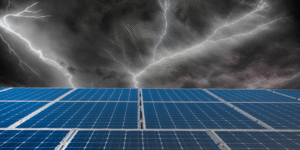Are you considering investing in solar energy for your property? You’re likely wondering about the longevity and resilience of these sleek, energy-generating marvels. The good news is that solar panels are surprisingly durable and designed to withstand the elements for decades, making them a reliable long-term investment.
Let’s delve into the factors that contribute to the impressive solar panel durability:
Built Tough: Materials and Construction
Modern solar panels are engineered with robust materials to ensure they can handle the challenges of outdoor exposure.
- Tempered Glass: Thick, tempered glass forms the top layer of most solar panels. This type of glass isn’t your average windowpane; it’s specifically designed to be highly resistant to impact, including hail. We test many panels to withstand hail up to a certain size and speed.
- Encapsulation: The delicate solar cells within the panel are protected by layers of encapsulant materials, often Ethylene-Vinyl Acetate (EVA). The material seals the cells from moisture, dust, and other environmental factors that could cause corrosion or degradation.
- Backsheet: A durable backsheet, often made of polymers, covers the back of the panel. This material provides further protection against moisture, UV radiation, and electrical insulation.
- Aluminum Frame: A sturdy aluminum frame encases most solar panels. This frame provides structural support, makes installation easier, and helps protect the edges of the panel from damage.
Standing Up to the Elements: Weather Resistance
Solar panels are designed to be outdoors for 25 to 30 years or even longer, so they must be able to withstand a variety of weather conditions.
- Rain and Humidity: The encapsulation and backsheet layers are crucial for preventing water ingress, which can damage the internal components and reduce efficiency.
- Wind: The engineering of solar panels and their mounting systems enables them to endure substantial wind loads. Proper installation is key to ensuring they remain securely attached to your roof or ground mount during strong winds.
- Snow and Ice: Solar panels can typically handle substantial snow loads. The dark surface of the panels also helps to absorb sunlight and generate heat, which can aid in melting snow.
- Temperature Fluctuations: While extreme heat can slightly reduce solar panel efficiency temporarily, the durable materials are designed to withstand a wide range of temperature fluctuations without structural damage.
- UV Radiation: The materials used in solar panels are UV-resistant to prevent long-term degradation from prolonged sun exposure, ensuring consistent solar panel performance over their lifespan.
- Hail: As mentioned earlier, the tempered glass is designed to withstand moderate hailstorms. While huge or severe hail can potentially cause damage, most panels are rigorously tested to meet industry standards for hail resistance.
Longevity and Degradation: The Long Haul
While incredibly durable, solar panel performance does gradually decrease over time. The result is a natural process called degradation. However, the rate of degradation is typically very slow, often around 0.5% to 0.8% per year.
Most reputable manufacturers offer performance warranties that guarantee their panels will produce at least 80% of their original power output after 25 years. This guarantees the expected lifespan and long-term reliability of solar panels. Some premium panels even boast lower degradation rates and longer warranty periods.
Protecting Your Investment: Warranties
Understanding solar panel warranties is crucial for peace of mind.
- Product Warranty: The guarantee typically covers manufacturing defects in the panel itself and usually lasts for 10-12 years, sometimes even up to 25 years for premium brands.
- Performance Warranty: This type of warranty guarantees a certain level of power output over a specified period, usually 25 years. It assures you that your panels will continue to generate a significant amount of electricity for decades.
Tips for Maximizing Solar Panel Lifespan
While solar panels are inherently durable, a few simple steps can help ensure they last as long as possible:
- Professional Installation: Proper installation according to manufacturer guidelines is crucial for the longevity and performance of your panels.
- Regular Monitoring: Monitor your system’s performance closely to detect any potential issues early on.
- Occasional Cleaning: Removing dust, dirt, and debris can help maintain optimal solar panel efficiency.
- Trim Overhanging Vegetation: Prevent shade and potential physical damage from tree branches.
The Verdict: Solar Panels are a Durable and Long-Lasting Investment
In conclusion, manufacturers build solar panels to be incredibly durable and withstand the rigors of long-term outdoor exposure. Their robust construction, weather-resistant design, and the backing of long warranties make them a reliable and sustainable energy solution. By understanding their durability, you can invest in solar with confidence, knowing that you’re making a choice that will provide clean energy and savings for decades to come.

